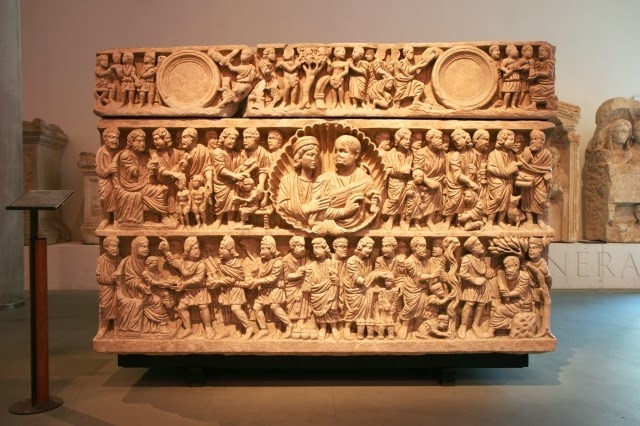Charles Le Brun (1619-1690)
Le baptême du centurion Corneille à Césarée
The Baptism of the Centurion Cornelius at Caesarea
1639
Oil on canvas
98 x 68 cm
Musée des Beaux-Arts, Nancy
Louis XIV declared Le Brun to be the greatest French painter of all time
He was certainly celebrated while he was still alive
This is an early work when he was still under the influence of Vouet. Later he went to Rome in 1642 and worked under Poussin
The theme of the painting is one of the important events which occurred after the first Pentecost
The incident is again related in
Acts 11:1–18 where Peter is forced to justify his actions before the Jerusalem community and alluded to in
Acts 15:7–11 where at the Jerusalem “Council” Peter supports Paul’s missionary activity among the Gentiles.
The narrative concludes with Peter’s presentation of the Christian kerygma (Acts 10:4–43) and a pentecostal experience undergone by Cornelius’ household preceding their reception of baptism
"15 As I began to speak, the holy Spirit fell upon them as it had upon us at the beginning,
16 and I remembered the word of the Lord, how he had said, ‘John baptized with water but you will be baptized with the holy Spirit.’
17 If then God gave them the same gift he gave to us when we came to believe in the Lord Jesus Christ, who was I to be able to hinder God?”
18 When they heard this, they stopped objecting and glorified God, saying, “God has then granted life-giving repentance to the Gentiles too.” "
It was a very controversial act in its time. Its legitimacy was only settled by the Council of Jerusalem
The ramifications and significance of the event was reflected in early Christian art
Joseph Wilpert (1857 - 1944) in
I sarcofagi Cristiani Antichi (1929, 1932) and his other works is at pains to emphasise the frequency of the depiction of the scene and therefore its significance in the early Church
He writes:
"In Rome Christians converted for the most part from being pagan ...
It is therefore no wonder that the baptism of Cornelius became in the art found in cemeteries the scene which far exceeded in number all other scenes . In sculpture alone there are at least one hundred known examples ... and we shall be adding another twenty examples hitherto unpublished."
(Wilpert, I sarcofagi Cristiani Antichi, Volume I, page 111 (1929))
Here are some examples
Sarchophagus of the handing of the law to Peter
With separate panel showing the Baptism of Cornelius and the miraculous source of the living water
White Carrara marble
4th century
Musée départemental Arles antique, Arles, France
The story of the Baptism of Cornelius is associated with that of Moses in the desert (which prefigures the rite of Baptism)
On the arrival of Peter, Cornelius prostrated himself before him
Like Moses, Peter carries a rod similar to that of Moses with which he performed the miracle in the desert
Cornelius is dressed in the armour of the centurion. Other soldiers from his regiment can be seen
Séraphin Médéric Mieusement 1840 - 1905
"Tombeau antique" au musée d'Arles (4th century AD white Carrara marble)
1888
0.25 m x 0.364 m
Musée d'Orsay, Paris, France
In this photograph image of a 4th century tomb in the Musée départemental Arles antique, Arles, the scene between Peter and Cornelius is on the top right of the sarcophagus
Sarcophage des époux (Sarcophagus of the Spouses, also known as the Sarcophagus of the Trinity)
With detail showing The Baptism of Cornelius and the miraculous source
2.05m x 1.09m x 1.05m
Second half of 4th century
White marble
Musée départemental Arles antique, Arles, France
This was one of three sarcophagi discovered in Trinquetaille, Arles in 1974
The sarcophagus has scenes from The Old Testament, the mirac;es of Christ and scenes from the life of St Peter
Peter is depicted as "the new Moses": the receiver and giver of the Law and the means by which the Source of the Water of Life is discovered
It bears similarities to the
"Dogmatic" Sarcophagus of AD 320 -350 now in The Vatican Museums
As Wilpert emphasises, it is this vision and revelation accorded to St Peter in the episode involving Cornelius which for the early Church was one of the main reasons for the primacy among the Apostles to be accorded to St Peter and his successors
Without the vision and the revelation the Christian Church would have been very different



























